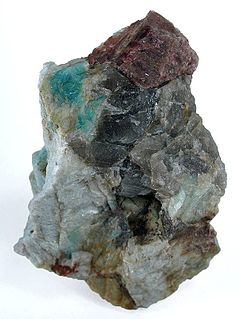- Danalite
-
Danalite 
General Category Sodalite - Feldspathoid Chemical formula Fe2+4Be3(SiO4)3S Strunz classification 09.FB.10 Dana classification 76.02.04.02 Identification Color Yellow, pink, reddish brown, red: colorless to pink in thin section Crystal habit Octahedral and dodecahedral crystals, typically massive or as segregations Crystal system Isometric - hextetrahedral (4 3m) Cleavage {111} and {111} Fracture Subconchoidal to uneven Tenacity Brittle Mohs scale hardness 5.5 to 6 Luster Vitreous or greasy Streak Grey white Diaphaneity Semitransparent Specific gravity 3.28 - 3.46 Optical properties Isotropic Refractive index n = 1.747 - 1.771 References [1][2][3] Danalite is an iron beryllium silicate sulfide mineral with formula: Fe2+4Be3(SiO4)3S.
It is a rare mineral which occurs in granites, tin bearing pegmatites, contact metamorphic skarns, gneisses and in hydrothermal deposits. It occurs in association with magnetite, garnet, fluorite, albite, cassiterite, pyrite, muscovite, arsenopyrite, quartz, and chlorite.[1]
Danalite was first described in 1866 from a deposit in Essex County, Massachusetts and named for American mineralogist James Dwight Dana (1813–1895).[3]
It has been found in Massachusetts, New Hampshire, Sierra County, New Mexico; Yavapai County, Arizona; Needlepoint Mountain, British Columbia; Walrus Island, James Bay, Quebec; Sweden; Cornwall, England; Imalka and Transbaikal, Russia; Kazakhstan; Somalia; Tasmania; Western Australia and Hiroshima Prefecture, Japan.[1][2]
References
- ^ a b c http://rruff.geo.arizona.edu/doclib/hom/danalite.pdf Handbook of Mineralogy
- ^ a b http://www.mindat.org/min-1341.html Mindat.org
- ^ a b http://webmineral.com/data/Danalite.shtml Webmineral data

This article about a specific silicate mineral is a stub. You can help Wikipedia by expanding it.
